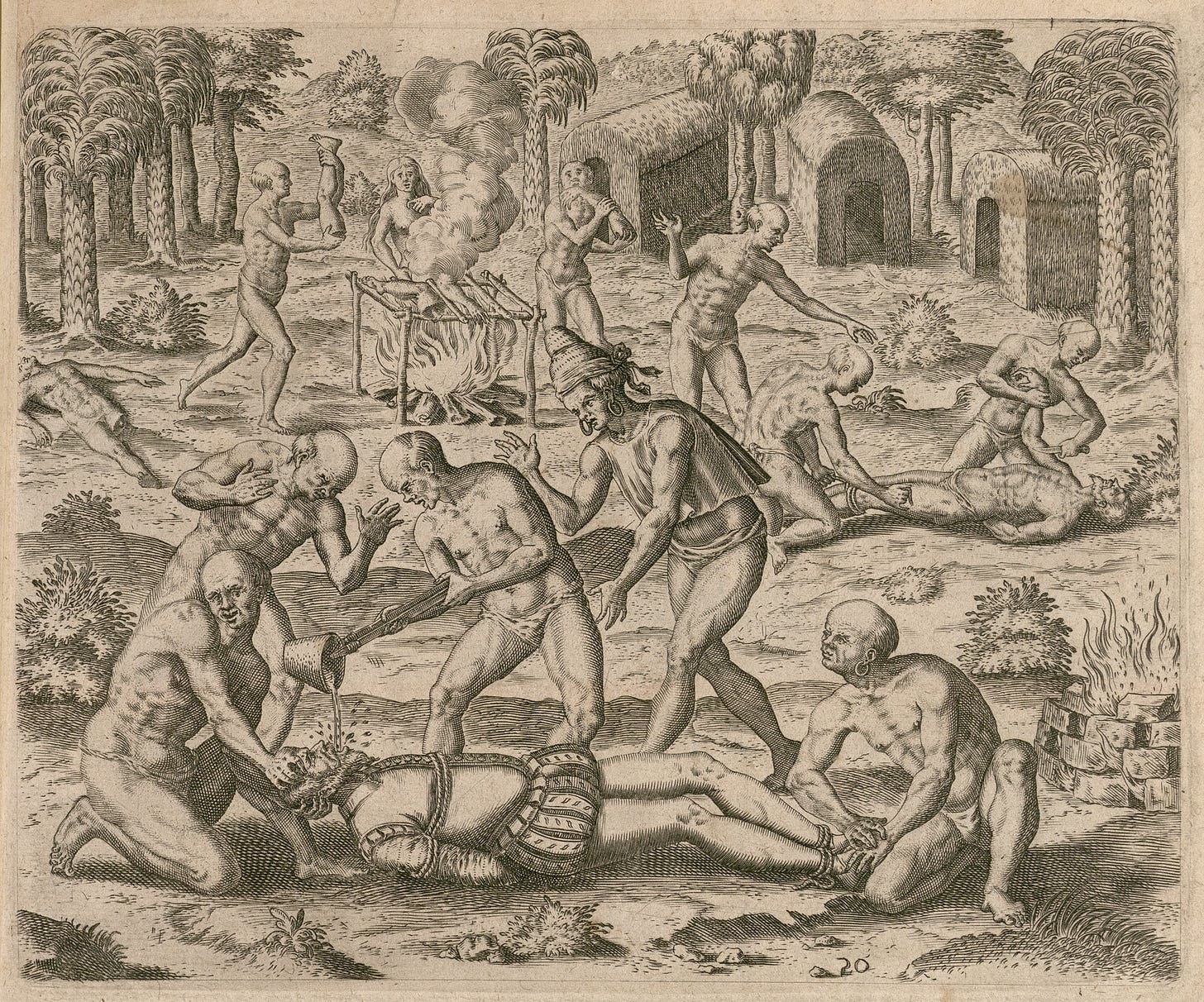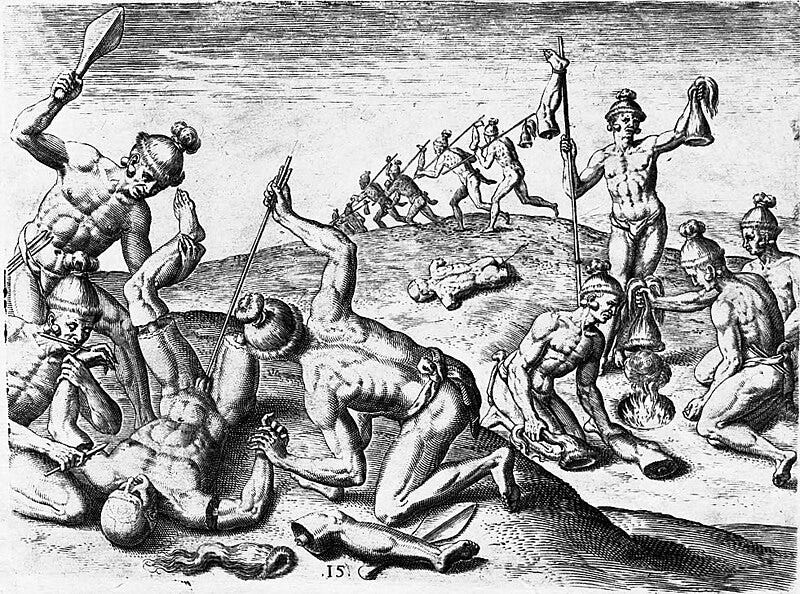How Colonist Anxiety and Misunderstanding are Interpreted Through Art and Literature of the New World
Much of the understanding that historians have today about the interactions between European colonizers and indigenous peoples in the early Atlantic World actually revolves greatly around the former’s own projections and prejudices which they placed upon the latter. The tangible evidence, such as the art and literature produced, are ways of contextualizing firsthand the kind of notions that European colonizers were creating as a result of their own misunderstandings and demonization of the new world and its inhabitants. Some such examples are seen in art including engravings by Theodor de Bry and Jacques le Moyne, as well as literature produced by writers such as Jean Bodin. Furthermore, the contemporary texts which analyze these primary sources are ways of further understanding the interpersonal interactions within as well as the perceptions about the New World during the 16th and 17th centuries.
Images produced by humans are seldom completely factually accurate, as many incorporate their own internal biases and personally held notions into their art. This sentiment rings true in the case of many of the engravings that were produced by colonizing artists being outlets for them to depict their own anxieties and misunderstandings of the New World around them. Notably, Flemish engraver Theodor de Bry created a piece entitled Native Americans Pour Molten Gold into the Throats of Spaniards from c. 1590 that included a scene in the foreground of the native peoples, as the title suggests, revolting against their oppressors by pouring molten gold down their throats.
This work is a blatant example of the anxieties that colonists had in regards to the possibility of revolt in the New World. Perhaps as a way of projecting his own feelings about the torture that colonists inflicted upon Natives, De Bry was likely acknowledging the fact that it was possible, and in some cases a reality, that their karmic retribution would meet them in a similar fate. Furthermore, the background shows other Native individuals cutting off then roasting human limbs, such as arms and legs, over a fire, as if they are about to consume them. This proves how this piece can be argued as an example of the common belief, as perpetuated by such art and ideas being spread to the Old World, that indigenous peoples were inherently savage and violent. By depicting and spreading misinformation about what they do not know and do not care to understand, European colonizers are insinuating that such savagery and violence justified their now ‘noble’ efforts to overtake and subdue them. This idea is further depicted by other artists of the same time, such as Jacques le Moyne, who produced similar art to be spread to the Old World.
The aforementioned artist, Jacques le Moyne, created a piece entitled How the Indians Treated the Corpses of their Enemy in 1591, that also depicts similar violent imagery in hopes to convey the idea that indigenous peoples were savage and therefore deserving of being killed and conquered.
In the foreground, the viewer sees indigenous men, apparently identifiable by their hairstyles, jewelry, and lack of clothing, in the process of cutting off the limbs of their ‘enemies’. This is similar to De Bry’s engraving, yet differs in subject matter as this is meant to convey the battle conventions of indigenous peoples. To the center of the piece, one may also see other men marching with human limbs affixed to what appear to be spears. At right, more men are seen surrounding a fire which cooks a head, as well as a man standing triumphantly before it holding a leg in his right hand and a head in his right, both high in the air. The scenes in this artwork further contribute to the pervasive ideas of indigenous peoples having customs that are overtly different, and therefore more negative and fearsome, than ones practiced by Europeans of the Old World. This is extremely dangerous because many of the depictions of Native Americans, such as this one, are not completely factual and instead aim to spread misinformation that they have never had any intention of correcting. This reveals to historians that not only were Europeans often overcompensating for their own fears of Indigenous peoples and their practices, but that they also selfishly were void of any intentions of attempting to understand what they did not.
Alternatively, yet in a similar vein, the literature that was produced by colonists of the 16th century also reveals a lot about their preconceptions of and interactions with indigenous peoples of the New World. Evident in the work of Jean Bodin, namely in the third chapter of his On the Demon Mania of Witches entitled “The Difference between Good and Evil Spirits”, the reader may infer just how little Bodin understands the culture, and namely the religion, of the indigenous peoples of America. This is unfortunately a common thread that runs through much of the literature of the time. In reference to the religious practices of indigenous peoples in the New World and how they are an example of succumbing to the ‘evil spirits’ that he speaks of, Bodin states that “The Devil was able to maintain this so successfully that in the Western Islands [America] it was found before the Spaniards took possession there, that their priests made great fasts, prayers and processions, bearing their idols as standards and singing in their honour.” (Bodin, 63). What we understand today as a harmless procession of polytheistic worship, was seen to scholars such as Bodin as the work of the devil, apparently. By arguing that the indigenous peoples’ worship of various gods for different intended purposes was simply worship of the Devil, but in a different form, Bodin creates further evidence of the aforementioned pervasive theme of European thinkers automatically demonizing and villainizing anything which they did not understand. To further corroborate this, Ronald Hutton expands the argument to include the idea that, as Dr. Martel explains, “Christianization wiped out ancient land-based spiritualities in Europe and that there were no “pagan survivals” in early modern Europe” (Martel, 2024). It is not surprising that ‘alternative’ religious beliefs and practices, such as Paganism, could not thrive in early modern Europe, especially based on the massive efforts to make Christianity the forefront of every person’s identity and religious affiliation. A large aspect of colonization in the Americas was also based around the spread of Christian ideas and the subsequent punishment of those who did not submit to following them. Both of these facts allow for Hutton’s theory to be feasible, as Paganism and other indigenous religions would have likely thrived without the influences of colonization and European pressures.
In studying the art and literature produced by Europeans in the 16th and 17th centuries, the representations of the indigenous peoples within them allow for historians to contextualize them not as accurate fact, but instead as outlets for understanding their own projections and prejudices. By analyzing the art created by Theodor de Bry and Jacques le Moyne, one understands just how harmful the mass production of engravings and prints was in creating the narrative of indigenous peoples as savage and violent. Similarly, the literature from Bodin reveals that Europeans placed their own projections and fears of demons onto indigenous people and their ways of worship, as a result of not understanding their Gods and practices. Both of these types of sources, artistic and literature based, perpetuated the warped and blatantly untrue belief that colonization was a noble and justified effort which aimed to civilize and salvage both the people and land of the New World.



